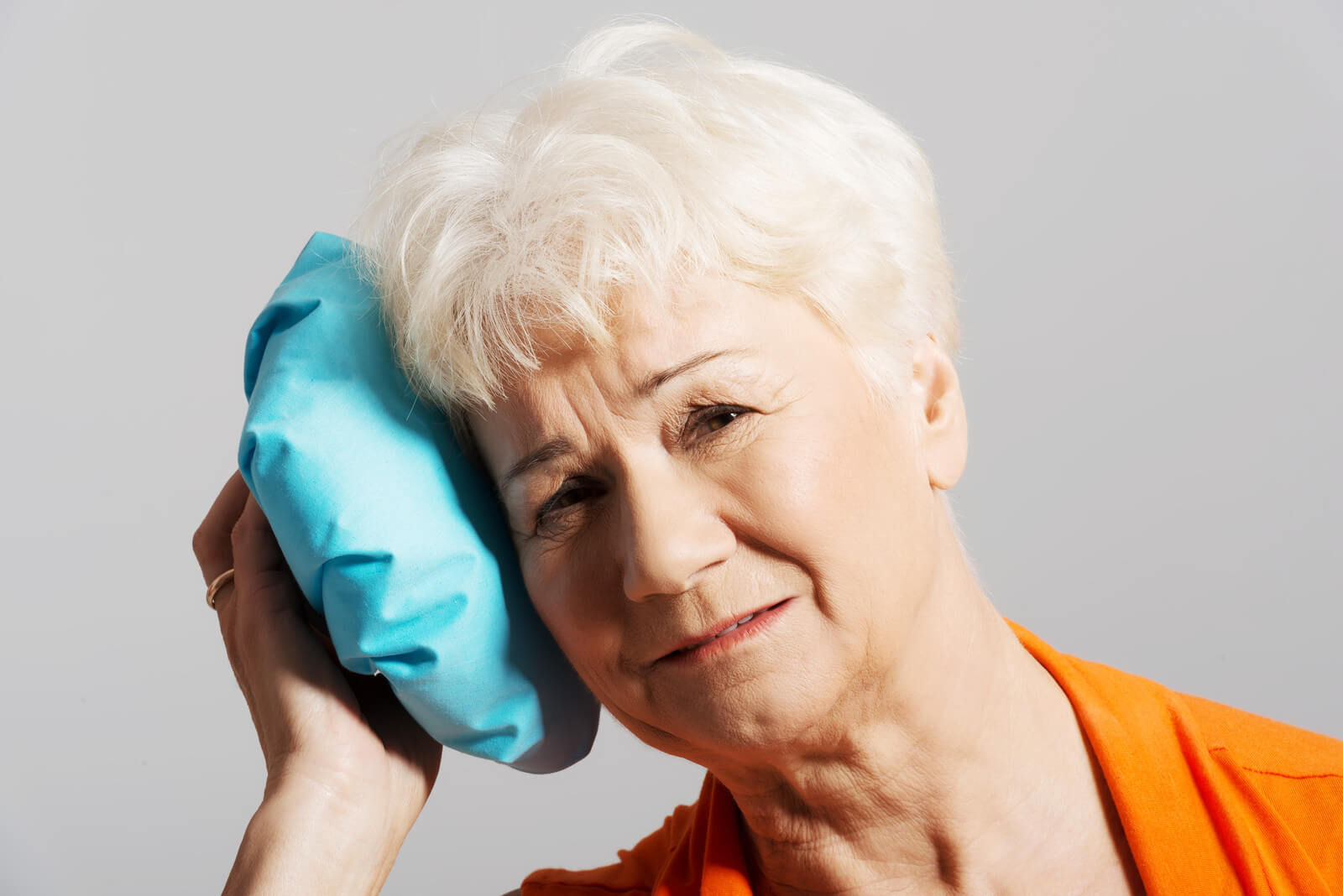FTC disclaimer: This post may contains affiliate links and we will be compensated if you click on a link and make a purchase.
If you experience headaches regularly, you may be looking for ways to find relief. Applying an ice pack to your head can be a simple and effective way to reduce pain.
Ice can help to constrict blood vessels, which can reduce inflammation and swelling. It can also numb the area, providing temporary pain relief.
You may find that using an ice pack for headaches, migraines, or sinus headaches gives you the relief you need.
Is an ice pack good for headaches?

If you suffer from headaches, you may wonder if an ice pack is a good option for relief. The short answer is that it can be, but it depends on the type of headache you have.
Ice can help reduce inflammation and pain in the short term so it can be helpful for headaches caused by sinus infections or toothaches.
However, it’s essential not to use ice for more than 20 minutes at a time, as it can actually cause headaches in some people.
If you have a tension headache, ice may not be the best option. These headaches are often caused by stress and tension in the neck and shoulders, and ice can worsen these symptoms. Instead, try massaging the area or taking a warm bath.
If you have a migraine, ice can help reduce the pain and inflammation, but it’s important to talk to your doctor before using it. Some people find that ice triggers their migraines, so it’s important to be aware of this before using it.
The study, published in the journal Cephalalgia, looked at the effects of ice on headaches.
A group of people with migraines were divided into two groups. One group was given an ice pack on their forehead for 20 minutes. The other group was given a placebo (a device with no real therapeutic effect).
The results showed that the ice pack group significantly reduced pain intensity and duration compared to the placebo group.
In general, ice is a safe and effective way to relieve pain in the short term. However, you must talk to your doctor if you’re experiencing headaches regularly, as there may be a more serious underlying condition.
So, there you have it. Ice packs can be helpful for both migraines and sinus headaches. They might be worth a try if you’re looking for a natural way to find relief.
How do ice packs work?
Ice packs are a popular home remedy for headaches, but how do they actually work?
For starters, it is crucial to understand that there are different types of headaches. Tension headaches, for example, are caused by muscle tension in the head and neck.
Migraines, on the other hand, are caused by changes in the brain.
Ice packs can help relieve both tension headaches and migraines. How? Well, for tension headaches, ice packs help to relax the muscles in the head and neck.
For migraines, ice packs help to constrict the blood vessels in the brain, which can help to reduce the pain.
Of course, ice packs are not a cure for headaches. But, they can help to relieve the pain and make it more bearable.
So, if you are suffering from a headache, try placing an ice pack on your forehead for 15-20 minutes. You may find that it helps to ease the pain.
Where do you put ice for a headache?
We all know that when we have a headache, we are supposed to put ice on it. But where exactly do you put the ice?
A new study has found that the best place to put ice for a headache is on the back of your neck.
The study, which researchers at the University of Melbourne conducted, found that putting ice on the back of your neck can help to relieve a headache more effectively than other methods, such as putting ice on your forehead or temples.
The study looked at a group of people suffering from migraines and found that those who put ice on the back of their necks had a significantly lower pain intensity than those who did not.
So, if you’re suffering from a headache, put the ice on the back of your neck. It may not be the most comfortable method, but it is the most effective.
How Cold Therapy Stops Headache or Migraine Pain?

When it comes to headaches, we typically think of taking medication to relieve the pain. But what if there was a way to stop headaches or migraine pain without medication? That’s where cold therapy comes in.
Cold therapy, also known as cryotherapy, is a treatment that involves exposing the body to extremely cold temperatures. Ice packs, cold baths, or even ice-cold water sprayed onto the skin can do this.
So how does cold therapy work to stop headaches or migraines?
One theory is that cold therapy helps to constrict blood vessels in the head, which can help to reduce inflammation and pain.
Another theory is that cold therapy works by numbing the nerves in the head, which can help to reduce the pain of a headache or migraine.
Whatever the mechanism, there is some evidence to suggest that cold therapy can be effective in treating headaches or migraines.
One study found that cold water immersion effectively reduced migraines’ pain.
Another study found that ice packs effectively reduced the pain of tension headaches.
So if you’re suffering from headaches or migraines, it may be worth giving cold therapy a try.
What is better for a headache, ice, or heat therapy?
If you’ve ever had headaches, they can range from mildly annoying to debilitating. And while there are a variety of over-the-counter and prescription medications available to help relieve the pain, sometimes nothing seems to work. So what’s a person to do?
Turn to ice or heat therapy, of course!
But which is better for a headache?
According to a new study published in the journal pain, the answer may depend on the type of headache you’re experiencing.
For the study, researchers recruited participants who were experiencing either episodic tension-type headaches or migraines.
Episodic tension-type headaches are the most common type of headache and are typically characterized by dull, aching pain that is felt on both sides of the head.
Conversely, migraines are more severe and can accompany other symptoms, including nausea, vomiting, and sensitivity to light and sound.
Participants in the study were randomly assigned to one of three groups: those who received ice therapy, those who received heat therapy, and those who received no therapy at all (the control group).
The ice therapy group sat with an ice pack on their forehead for 20 minutes, while the heat therapy group sat with a heating pad on their forehead for 20 minutes. The control group did not receive any therapy.
All groups were asked to rate their pain on a scale of 0 to 10 before and after the therapy, with 0 being no pain and 10 being the worst pain imaginable.
The results showed that, for episodic tension-type headaches, ice therapy was more effective than heat therapy or no therapy at all. However, heat therapy was more effective for migraines than ice therapy or no therapy.
So, if you’re unsure which type of headache you’re experiencing, it may be worth trying ice and heat therapy to see which works better for you.
And if you’re still not sure, it never hurts to consult with a doctor or other healthcare professional to get an accurate diagnosis.
What is the benefit of putting ice on the back of the neck?
When treating headaches, one popular home remedy is putting ice on the back of the neck. But does this work?
There is some science to support the use of ice for headaches. A study published in the journal Cephalalgia found that ice therapy can effectively treat migraines.
The study found that ice therapy can help reduce migraines’ pain by numbing the trigeminal nerve, a major pain pathway.
So, it may be worth trying ice if you suffer from a headache. Just be sure to wrap the ice in a thin towel, so you don’t damage your skin.
Can an ice pack significantly lower your body temperature?
While there are many different types of headaches, tension headaches are the most common. Tension headaches are often caused by stress and can be very debilitating.
If you’re looking for a way to relieve your tension headaches, you may be interested in ice packs. But can an ice pack help to lower your body temperature?
According to a recent study, the answer may be yes.
The study, published in Cephalalgia Journal, recruited 25 participants suffering from tension headaches. The participants were asked to apply an ice pack to their forehead for 20 minutes.
The results of the study showed that the ice pack was effective in reducing the participants’ headache intensity. In addition, the ice pack also helped to lower the participants’ body temperature.
So, if you’re suffering from a tension headache, an ice pack may be worth a try. It’s a simple, drug-free way to help relieve your pain and lower your body temperature.
What are the best ice packs for migraines?
According to the National Institutes of Health, migraines affect about 12% of the population.
There are a variety of treatments for migraines, but one of the most effective is using an ice pack. Ice can help to numb the pain and can also help to reduce inflammation.
But what type of ice pack is the best for migraines?
There are a few different options when it comes to ice packs. You can use a simple ice pack at home or purchase an ice pack specifically designed for migraines.
If you opt for a store-bought ice pack, there are a few things to remember. First, you want to ensure that the ice pack is specifically designed for migraines. There are many different ice packs on the market, but not all are created equal.
Second, you’ll want to choose an ice pack that is comfortable to use. Some ice packs can be quite uncomfortable, so you must find one you can use without issue.
Finally, you’ll want to ensure that the ice pack is durable. Some ice packs can break easily, so you’ll want to choose one that will withstand a lot of wear and tear.
A few different types of ice packs can be used for migraines. One type is a gel pack, which can be filled with either water or gel. Gel packs are great because they conform to the head and can provide targeted relief.
Another type of ice pack is a bag of frozen vegetables. This is an excellent option if you don’t have a gel pack on hand. Just wrap the bag in a towel, so it doesn’t leak.
There are also ice packs that can be filled with air. These are great because they are less likely to leak, and they can be easily adjusted to the desired amount of pressure.
So, which type of ice pack is the best for migraines?
Well, that depends on what you’re looking for. A gel pack is a great option if you want something that will provide targeted relief. If you’re looking for something less likely to leak, then an air-filled ice pack is a good choice.
When choosing the best ice pack for migraines, there are a few different factors to consider. But, if you keep these factors in mind, you should be able to find the perfect ice pack for your needs.
Conclusion
Ice packs are an effective and affordable treatment for headaches, migraines, and sinus headaches.
They are easy to use and can be found in most households. Ice packs provide relief by reducing inflammation and swelling. When used correctly, ice packs can help prevent future headaches.








